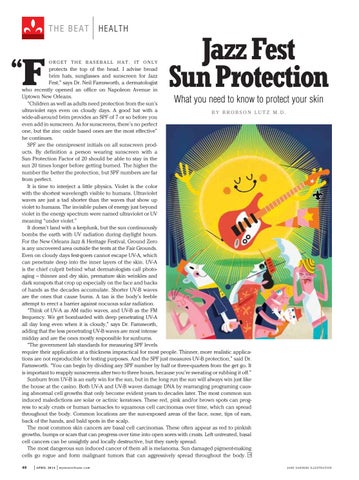T HE BEA T
F
‘‘
HEALTH
o r g e t t h e b a s e b a ll h a t . I t o n l y
Jazz Fest Sun Protection
protects the top of the head. I advise broad brim hats, sunglasses and sunscreen for Jazz Fest,” says Dr. Neil Farnsworth, a dermatologist who recently opened an office on Napoleon Avenue in Uptown New Orleans. “Children as well as adults need protection from the sun’s ultraviolet rays even on cloudy days. A good hat with a by B rob s on L u t z M . D . wide-all-around brim provides an SPF of 7 or so before you even add in sunscreen. As for sunscreens, there’s no perfect one, but the zinc oxide based ones are the most effective” he continues. SPF are the omnipresent initials on all sunscreen products. By definition a person wearing sunscreen with a Sun Protection Factor of 20 should be able to stay in the sun 20 times longer before getting burned. The higher the number the better the protection, but SPF numbers are far from perfect. It is time to interject a little physics. Violet is the color with the shortest wavelength visible to humans. Ultraviolet waves are just a tad shorter than the waves that show up violet to humans. The invisible pulses of energy just beyond violet in the energy spectrum were named ultraviolet or UV meaning “under violet.” It doesn’t land with a kerplunk, but the sun continuously bombs the earth with UV radiation during daylight hours. For the New Orleans Jazz & Heritage Festival, Ground Zero is any uncovered area outside the tents at the Fair Grounds. Even on cloudy days fest-goers cannot escape UV-A, which can penetrate deep into the inner layers of the skin. UV-A is the chief culprit behind what dermatologists call photoaging – thinner and dry skin, premature skin wrinkles and dark sunspots that crop up especially on the face and backs of hands as the decades accumulate. Shorter UV-B waves are the ones that cause burns. A tan is the body’s feeble attempt to erect a barrier against nocuous solar radiation. “Think of UV-A as AM radio waves, and UV-B as the FM frequency. We get bombarded with deep penetrating UV-A all day long even when it is cloudy,” says Dr. Farnsworth, adding that the less penetrating UV-B waves are most intense midday and are the ones mostly responsible for sunburns. “The government lab standards for measuring SPF levels require their application at a thickness impractical for most people. Thinner, more realistic applications are not reproducible for testing purposes. And the SPF just measures UV-B protection,” said Dr. Farnsworth. “You can begin by dividing any SPF number by half or three-quarters from the get go. It is important to reapply sunscreens after two to three hours, because you’re sweating or rubbing it off.” Sunburn from UV-B is an early win for the sun, but in the long run the sun will always win just like the house at the casino. Both UV-A and UV-B waves damage DNA by rearranging programing causing abnormal cell growths that only become evident years to decades later. The most common sun induced maledictions are solar or actinic keratoses. These red, pink and/or brown spots can progress to scaly crusts or human barnacles to squamous cell carcinomas over time, which can spread throughout the body. Common locations are the sun-exposed areas of the face, nose, tips of ears, back of the hands, and bald spots in the scalp. The most common skin cancers are basal cell carcinomas. These often appear as red to pinkish growths, bumps or scars that can progress over time into open sores with crusts. Left untreated, basal cell cancers can be unsightly and locally destructive, but they rarely spread. The most dangerous sun induced cancer of them all is melanoma. Sun damaged pigment-making cells go rogue and form malignant tumors that can aggressively spread throughout the body. 40
APRIL 2014
What you need to know to protect your skin
myneworleans.com
J ANE SAN D ERS I L L U STRATION
